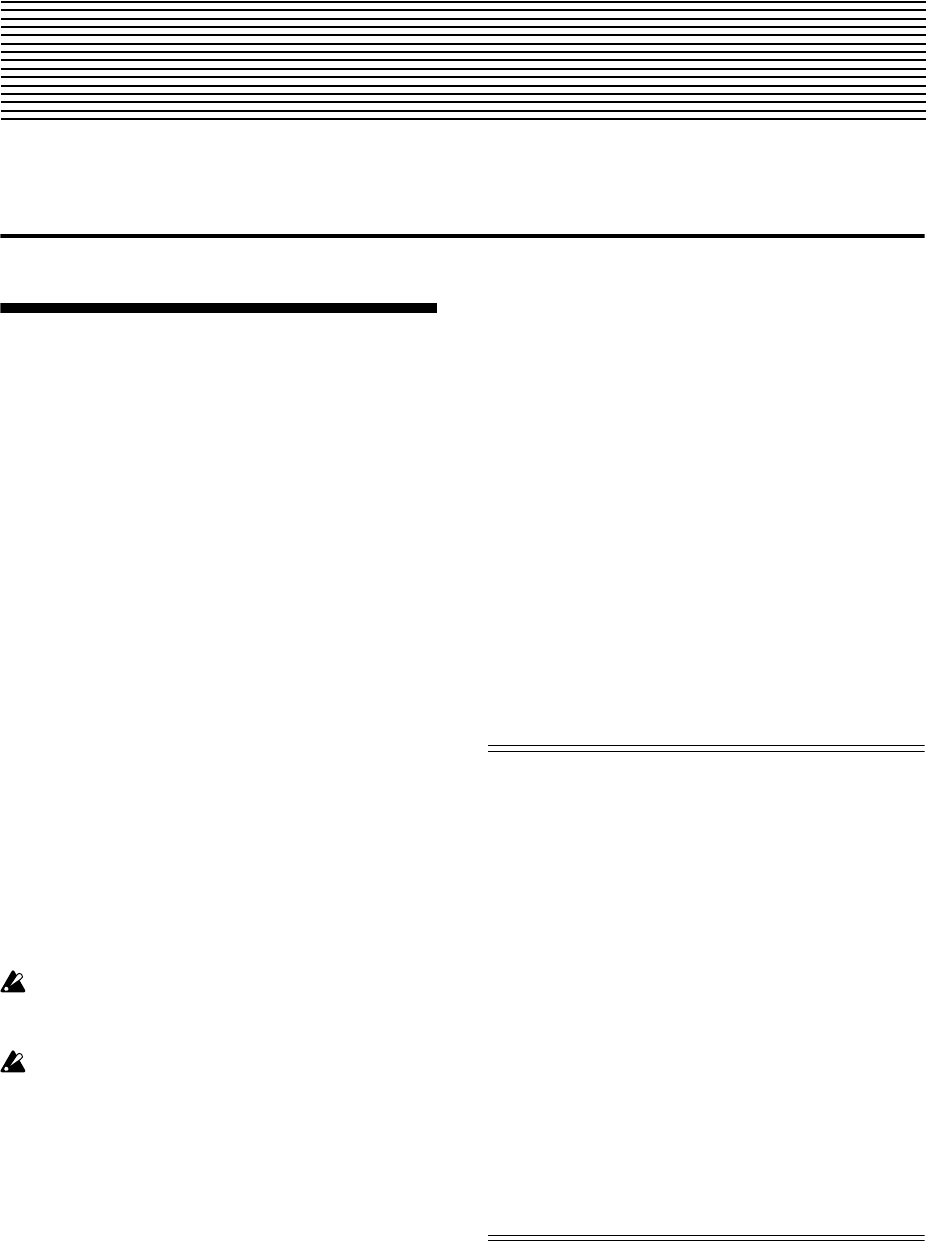
42
Basic functions
Saving data
Types of data that can be saved
On the TR, there are three ways to save data: writing to
internal memory, saving on external media (SD card
etc.), and MIDI data dump.
Writing to internal memory
The following data that you edit can be written into
internal memory.
• Program
Programs 0–127 in banks A–D
• Combination
Combinations 0–127 in banks A–C
• Global settings (Page 1.1–4.1)
• User drum kits 00 (INT)–23 (User)
• User arpeggio Patterns 000 (INT)–215 (User)
• User template songs U00-U15
Song settings such as the song name and tempo,
track settings (
☞p.64), arpeggiator settings, and
effect settings can be saved (Write) to internal mem-
ory. However, the musical data for song tracks and
patterns are not saved to internal memory. Further-
more, settings that govern how the musical data is
played back such as “Meter,” “Metronome,” “Play/
Mute,” “Track Play Loop (including Start/End Mea-
sure),” and RPPR settings will not be saved either.
Use the Sequencer mode Utility menu command
“Save Template Song” to write this data (
☞PG p.54).
Data that you edit in Sequencer or Sampling mode
(if the EXB-SMPL option is installed) cannot be
saved in internal memory by the Write operation.
If the EXB-SMPL (sold separately) option is
installed, and you are using RAM bank multisam-
ples or samples as the Multisample or Drum Kit
of a program, it is not possible to write this multi-
sample or sample data (i.e., to save it perma-
nently). This means that the sound of a program or
combination that uses RAM bank multisamples or
samples will not be reproduced the next time the
power is turned on. In order to reproduce these
sounds, the saved multisamples and samples must
be loaded from external media (e.g., SD card).
Saving to external media (SD card etc.)
The following data can be saved on external media (SD
card etc.). If the EXB-SMPL option is installed, this data
can also be saved on high-capacity media such as a
SCSI hard disk etc.
For details on the file format, refer to PG p.141.
• Programs, combinations, global settings, user
drum kits, and user arpeggio patterns
• Song and cue lists
• Standard MIDI Files (SMF)
Sequencer mode songs can be saved as SMF data.
• System exclusive data
System exclusive data received by the TR from an
external MIDI device (The TR can function as a data
filer.)
• Multisamples and sample data created in
Sampling mode (if the EXB-SMPL option is
installed)
MIDI data dump
The following types of data can be transmitted as a
MIDI data dump and saved on an external data filer or
other device.
• Programs, combinations, global settings, user
drum kits, and user arpeggio patterns
• Songs, cue lists
About preloaded data and preset data
Preloaded data is the data that is loaded into memory
at the factory. This data can be rewritten, and is written
into the various locations listed in the preceding sec-
tion “Writing to internal memory.” This data is main-
tained inside the TR, and can be reloaded using the
“Load Preload/Demo Songs” command (
☞p.48).
• Program banks A–D: 000–127
• Combination banks A–C: 000–127
• User drum kits 00 (INT)–15 (INT)
• User arpeggio patterns 000 (INT)–199 (INT)
• Demo songs 000–001
Preset data is data that cannot be rewritten by the
Write operation. This includes the following data.
• Program banks G: 001–128, g(d): 001–128
• Preset drum kits 64 (GM)–72 (GM)
• Preset arpeggio patterns P000-P004
• Preset template songs P00–P15
• Preset patterns P000–P149
• Program audition riffs 000–383


















